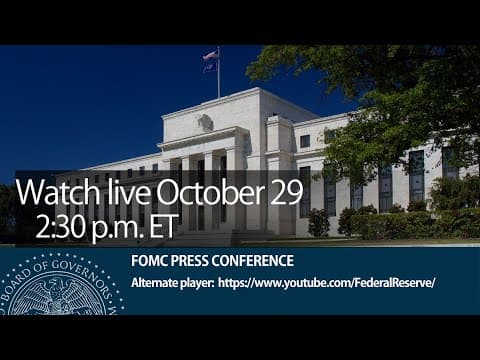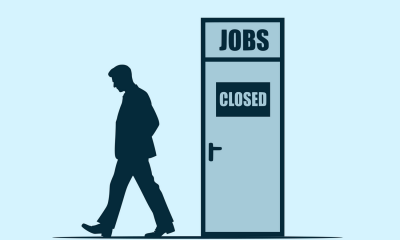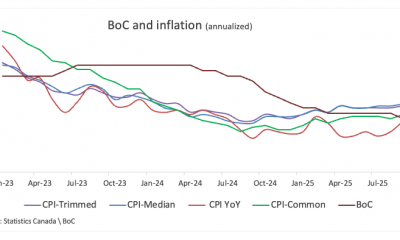

others
We’re 150 basis points closer to neutral – Crypto News
At the post-meeting press conference, Fed Chair Jerome Powell explained why policymakers had decided to lower the Federal Funds Target Range (FFTR) to 3.75%–4.00% after the October meeting and took questions from reporters about the move.
Chief Powell’s press conference takeaways
Data available suggests the outlook for employment and inflation has not changed much since the September meeting.
Prior to shutdown, data showed the economy may be on a firmer trajectory.
Shutdown will weigh on economic activity while it persists and should reverse when it ends.
Labour demand has clearly softened.
Available evidence suggests layoffs and hiring remain low.
Job availability and hiring difficulty continue to decline.
Inflation remains somewhat elevated relative to the goal.
Estimate total PCE and core PCE rose 2.8%.
Disinflation in services continues.
Most measures of long-term inflation expectations are consistent with the goal.
Higher tariffs are pushing up some goods prices.
Reasonable base case is that tariff effects on inflation will be short-lived.
Risk of more persistent inflation needs to be managed.
Obligation is to ensure it does not become an ongoing problem.
Risks to inflation are to the upside; to employment, they are to the downside. Challenging.
We must take a balanced approach.
Balance of risks has shifted.
Well-positioned to respond in a timely way to economic developments.
We face two-sided risks.
Different views about how to proceed in December.
Strongly differing views at the meeting about how to proceed.
Another cut in December is far from assured.
December cut is not for sure, far from it.
Tension between two goals, strong views across the committee.
We had strongly differing views today.
Today’s cut was risk management.
Going forward is a different thing.
We couldn’t address both employment and inflation risks with our one tool.
Policymakers had different forecasts and different risk tolerance.
Tightening of the money market in the recent three weeks.
Clear assessment we were only slightly above ample in reserves.
Not a lot of benefit to continuing to shrink the balance sheet.
Support on the committee to announce the December 1 freeze of balance sheet size.
If data showed the labour market was stabilising or strengthening, it would play into policy decisions. Openings suggested gradual cooling, giving some comfort.
If there were a significant change in the economy, we would pick that up.
If there was a high level of uncertainty, that could be an argument for caution on moving.
Labour market was not clearly declining quickly.
Directionally, CPI was a little softer than expected.
Goods prices were moving inflation up, but the good news is that housing services inflation was coming down.
Inflation away from tariffs was not so far from the 2% goal.
Didn’t see the tight labour market or inflation expectations moving, which could make inflation rise persistent.
We were not just assuming it would be one-time inflation from tariffs.
Policy was modestly restrictive.
That was one reason we saw the labour market gradually cooling.
We had moved 150 basis points, now in range where many estimates of the neutral rate lived.
Some people on the committee felt it was time to take a step back.
We were 150 basis points closer to neutral than we were a year ago.
It took a while for tariffs to reach consumers.
Consumer spending had been supportive, and that was a big part of what was going on.
We did not see weakness in the job market accelerating.
Job creation was very low.
It would not have been appropriate to assume away the inflation issue.
At the same time, the risk of higher inflation had declined since April.
This section below was published at 18:00 GMT to cover the Federal Reserve’s policy decisions and the immediate market reaction.
At its October meeting, the Federal Reserve cut its interest rate by 25 basis points, bringing the Federal Funds Target Range (FFTR) down to 3.75%–4.00%, right in line with what markets were expecting.
Highlights from the FOMC statement
The Fed cuts the key overnight interest rate to 3.75-4.00% range, says downside risks to employment rose in recent months.
Available indicators suggest economic activity is expanding at a moderate pace; job gains have slowed this year, and the unemployment rate has edged up but remained low through August.
More recent indicators are consistent with these developments.
Inflation has moved up since earlier in the year and remains somewhat elevated.
Uncertainty about the economic outlook remains elevated.
Policy committee is attentive to risks to both sides of the dual mandate; judges downside risks to employment have risen.
Vote in favour of the policy was 10-2, with Governor Miran preferring a half-percentage point cut and Kansas City President Schmid preferring no cut.
To conclude the aggregate balance sheet drawdown on December 1.
Beginning December 1, it will roll over all maturing Treasury principal payments.
Beginning December 1, it will reinvest all mortgage-backed securities principal payments into Treasury bills.
Market reaction
The Greenback maintains its upbeat performance on Wednesday, motivating the US Dollar Index (DXY) to keep its bid bias around the 98.90 zone alongside a positive performance of US yields across the curve.
US Dollar Price Today
The table below shows the percentage change of US Dollar (USD) against listed major currencies today. US Dollar was the strongest against the Swiss Franc.
| USD | EUR | GBP | JPY | CAD | AUD | NZD | CHF | |
|---|---|---|---|---|---|---|---|---|
| USD | 0.08% | 0.39% | 0.15% | -0.27% | -0.30% | -0.11% | 0.48% | |
| EUR | -0.08% | 0.31% | 0.07% | -0.34% | -0.38% | -0.19% | 0.40% | |
| GBP | -0.39% | -0.31% | -0.22% | -0.65% | -0.69% | -0.50% | 0.09% | |
| JPY | -0.15% | -0.07% | 0.22% | -0.44% | -0.47% | -0.23% | 0.31% | |
| CAD | 0.27% | 0.34% | 0.65% | 0.44% | -0.04% | 0.18% | 0.74% | |
| AUD | 0.30% | 0.38% | 0.69% | 0.47% | 0.04% | 0.20% | 0.78% | |
| NZD | 0.11% | 0.19% | 0.50% | 0.23% | -0.18% | -0.20% | 0.59% | |
| CHF | -0.48% | -0.40% | -0.09% | -0.31% | -0.74% | -0.78% | -0.59% |
The heat map shows percentage changes of major currencies against each other. The base currency is picked from the left column, while the quote currency is picked from the top row. For example, if you pick the US Dollar from the left column and move along the horizontal line to the Japanese Yen, the percentage change displayed in the box will represent USD (base)/JPY (quote).
This section below was published at 10:00 GMT as a preview of the Federal Reserve’s policy announcements.
- The US Federal Reserve is expected to cut the policy rate after the October meeting.
- The statement language and Fed Chair Powell’s comments will be key in the absence of economic data releases.
- The US Dollar faces a two-way risk amid potential changes to market pricing of the rate outlook.
The United States (US) Federal Reserve (Fed) will announce its interest rate decision and publish the Monetary Policy Statement following the October policy meeting on Wednesday.
Market participants widely anticipate the US central bank to cut the policy rate by 25 basis points (bps), lowering it to the range of 3.75%-4%.
The CME FedWatch Tool shows that investors are fully pricing in the 25 bps reduction in October and see about a 95% probability of one more 25 bps cut at the last policy meeting of the year in December.
The revised Summary of Economic Projections (SEP), published in September by the Fed, showed that policymakers’ projections implied two more 25 bps cuts in 2025, followed by 25 bps reductions in both 2026 and 2027.
According to a recently-conducted Reuters poll, 115 of 117 economists have predicted that the Fed will opt for a 25 bps cut in October, while 83 of them saw one more 25 bps cut in December. Moreover, 25 of 33 economists noted that the bigger risk to the Fed rate policy by the end of this cycle is that it would set rates too low.
The Fed’s meeting will take place under unusual circumstances. The federal government entered a shutdown on October 1 after Congress failed to pass new funding legislation. As a result, several key macroeconomic data releases that the Fed assesses when setting its monetary policy have been suspended, including the monthly September employment report and multiple weekly Initial Jobless Claims data. The Consumer Price Index (CPI) data for September, originally scheduled to be published on October 15, was released with a delay on October 24. The report showed that the CPI and the core CPI rose by 0.3% and 0.2%, respectively. Both of these prints came in softer than analysts’ estimates.
TD Securities analysts agree that the US central bank will likely continue recalibrating policy closer to neutral, implementing another 25 bps cut. “Despite mounting uncertainty amid the lack of data releases, we still expect the Committee’s guidance to tilt dovish. Chair Powell will likely continue walking a fine line when flagging signs of labor market weakness. The risk of persistent inflation remains a risk,” they add.
Fed Chair Powell recently indicated that they could be nearing the end of the quantitative tightening (QT) and stop reducing the size of the central bank’s bond holdings. The Fed could either officially announce that it will stop the balance sheet runoff or provide a future date. Deutsche Bank analysts argue Fed Chair Powell will focus on the balance sheet policy and the policy framework review in the press conference. “On QT, our team expects the Fed to announce an end to the programme today, with the run-off concluding next month,” they note.
When will the Fed announce its interest rate decision and how could it affect EUR/USD?
The Fed is scheduled to announce its interest rate decision and publish the Monetary Policy Statement at 18:00 GMT. This will be followed by Fed Chair Jerome Powell’s press conference starting at 18:30 GMT.
The rate decision itself is unlikely to trigger a significant market reaction. Moreover, it shouldn’t be a surprise to see policymaker Stephen Miran dissent with a vote for a 50 bps cut.
Since a December rate cut is largely priced in, the US Dollar (USD) could gather strength if the policy statement, or Fed Chair Powell, adopts a cautious tone on further policy easing, citing the uncertainty created by the lack of economic data. Additionally, any comments suggesting heightened upside inflation risks, while economic activity remains healthy, could have a similar effect on the USD’s performance and drag EUR/USD lower.
Conversely, the USD could come under pressure if Powell notes that the government shutdown could further hurt the labor market and cause the central bank to put more weight on the employment side of its mandate. Also, an optimistic tone on the inflation outlook could be seen as dovish and intensify the USD weakness, opening the door for a leg higher in EUR/USD.
Societe Generale analysts note that the US’ Gross Domestic Product (GDP) growth was well above potential, at least until the third quarter, and inflation continued to rise. “There are justified concerns about a weakening labour market and the potential damage from high and rising uncertainty. The thick fog left by the absence of data ought to tilt the balance towards something of an “insurance” cut. That said, the decision is again likely to not be unanimous,” they explain.
Eren Sengezer, European Session Lead Analyst at FXStreet, provides a short-term technical outlook for EUR/USD:
“EUR/USD manages to hold slightly above the lower limit of an ascending regression channel coming from January, and the Relative Strength Index (RSI) indicator on the daily chart stays near 50, suggesting that the bullish bias remains intact but lacks strength.”
“The 100-day Simple Moving Average (SMA), the 50-day SMA and the 20-day SMA converge in the 1.1650-1.1700 area, offering initial resistance to the pair. A decisive move above this region could attract technical buyers. In this scenario, 1.1920 (September 17 high) could be seen as the next resistance level before 1.2000 (mid-point of the ascending channel, round level). Looking south, the first support could be spotted at 1.1600 (lower limit of the ascending channel). A daily close below this level could open the door for an extended slide toward the 200-day SMA, currently located near 1.1300.”
Inflation FAQs
Inflation measures the rise in the price of a representative basket of goods and services. Headline inflation is usually expressed as a percentage change on a month-on-month (MoM) and year-on-year (YoY) basis. Core inflation excludes more volatile elements such as food and fuel which can fluctuate because of geopolitical and seasonal factors. Core inflation is the figure economists focus on and is the level targeted by central banks, which are mandated to keep inflation at a manageable level, usually around 2%.
The Consumer Price Index (CPI) measures the change in prices of a basket of goods and services over a period of time. It is usually expressed as a percentage change on a month-on-month (MoM) and year-on-year (YoY) basis. Core CPI is the figure targeted by central banks as it excludes volatile food and fuel inputs. When Core CPI rises above 2% it usually results in higher interest rates and vice versa when it falls below 2%. Since higher interest rates are positive for a currency, higher inflation usually results in a stronger currency. The opposite is true when inflation falls.
Although it may seem counter-intuitive, high inflation in a country pushes up the value of its currency and vice versa for lower inflation. This is because the central bank will normally raise interest rates to combat the higher inflation, which attract more global capital inflows from investors looking for a lucrative place to park their money.
Formerly, Gold was the asset investors turned to in times of high inflation because it preserved its value, and whilst investors will often still buy Gold for its safe-haven properties in times of extreme market turmoil, this is not the case most of the time. This is because when inflation is high, central banks will put up interest rates to combat it.
Higher interest rates are negative for Gold because they increase the opportunity-cost of holding Gold vis-a-vis an interest-bearing asset or placing the money in a cash deposit account. On the flipside, lower inflation tends to be positive for Gold as it brings interest rates down, making the bright metal a more viable investment alternative.
-

 others1 week ago
others1 week agoRisk-off sentiment drives selective equity positioning – BNY – Crypto News
-
others1 week ago
‘Floki Is The CEO’: FLOKI Surges Over 20% After Elon Musk’s Name Drop – Crypto News
-
others1 week ago
Ethereum Price Targets $8K Amid John Bollinger’s ‘W’ Bottom Signal and VanEck Staked ETF Filing – Crypto News
-
others1 week ago
Data Shows Bitcoin Short Squeeze Likely With Speculation of “Bullish” US CPI – Crypto News
-

 De-fi1 week ago
De-fi1 week agoCrypto Markets Recover Slightly as Fed Signals Rate Cut, End of QT – Crypto News
-

 others1 week ago
others1 week agoAustralian Dollar pares gains as US Dollar steadies on easing US-China tensions – Crypto News
-

 Technology1 week ago
Technology1 week agoAWS says it has fixed the problem that crippled half the internet but many popular apps are still down – Crypto News
-

 others1 week ago
others1 week agoAUD/USD rises on US-China trade hopes, Fed rate cut outlook – Crypto News
-

 De-fi1 week ago
De-fi1 week agoCrypto Markets Recover Slightly as Fed Signals Rate Cut, End of QT – Crypto News
-
Business1 week ago
Solana Price Eyes $240 Recovery as Gemini Launches SOL-Reward Credit Card – Crypto News
-

 De-fi1 week ago
De-fi1 week agoCrypto Markets Recover Slightly as Fed Signals Rate Cut, End of QT – Crypto News
-
others1 week ago
BREAKING: 21Shares Amends S-1 for Spot Dogecoin ETF Approval – Crypto News
-
Business1 week ago
Breaking: Michael Saylor’s Strategy Acquires 168 Bitcoin as Crypto Market Rebounds – Crypto News
-
others1 week ago
Analyst Predicts $10k ETH Price as Vitalik Buterin Launches Major Upgrade for Faster Proofs Systems – Crypto News
-

 Technology1 week ago
Technology1 week agoAmazon Web Services outage: Here’s how many users are impacted and the downtime costs – Crypto News
-
Business1 week ago
Bitcoin Price Prediction as Gaussian Channel Turns Green Amid U.S.–China Trade Progress and Fed Rate Cut Hopes – Crypto News
-

 Technology1 week ago
Technology1 week agoEthereum’s Vitalik Buterin applauds Polygon for pioneering ZK technology – Crypto News
-

 Blockchain1 week ago
Blockchain1 week agoXRP Whales Flood Binance With Massive Deposits – Selling Pressure Mounts – Crypto News
-

 Technology1 week ago
Technology1 week agoLayerZero outlook: ZRO price on the edge ahead of $43M token unlock – Crypto News
-
Technology1 week ago
Blockchain for Good Alliance and UNDP AltFinLab Launch Blockchain Impact Forum – Crypto News
-
Technology1 week ago
Blockchain for Good Alliance and UNDP AltFinLab Launch Blockchain Impact Forum – Crypto News
-

 Blockchain1 week ago
Blockchain1 week agoTokenized Deposits for Payments, Treasury – Crypto News
-

 Metaverse6 days ago
Metaverse6 days agoTech layoffs: From Meta, Amazon to Google — these IT majors have cut AI related jobs – Crypto News
-

 Cryptocurrency1 week ago
Cryptocurrency1 week agoAster price tanks 20% as sell-off pressure hits altcoins – Crypto News
-
Business1 week ago
How Will “Unusual” US CPI Inflation Data Release Could Impact Fed Rate Cut, Crypto Market? – Crypto News
-

 De-fi1 week ago
De-fi1 week agoDeFi Earning Aggregator Turtle Raises $5.5 Million – Crypto News
-

 Blockchain1 week ago
Blockchain1 week agoBitcoin Weekly RSI Points To More Upside, But Can the Bulls Defend $107,000? – Crypto News
-

 Cryptocurrency1 week ago
Cryptocurrency1 week agoEthereum Founder Vitalik Buterin Explains GKR, Unbelievably Powerful Tech Scheme – Crypto News
-
Business1 week ago
Binance Founder CZ Predicts Bitcoin Will Flip Gold’s $30 Trillion Market – Crypto News
-

 others1 week ago
others1 week agoFocus shifts to Canadian inflation, trade jitters and US shutdown – Crypto News
-

 Metaverse1 week ago
Metaverse1 week agoEight brilliant AI tools to supercharge productivity – Crypto News
-

 Metaverse1 week ago
Metaverse1 week agoEight brilliant AI tools to supercharge productivity – Crypto News
-
Technology1 week ago
ProShares Files for Index Crypto ETF Tracking Bitcoin, Ethereum, XRP, and Solana – Crypto News
-

 Technology1 week ago
Technology1 week agoThinking of cancelling HBO Max? Subscription prices just went up – Here’s what you need to know – Crypto News
-
Technology1 week ago
$1.68 Trillion T. Rowe Price Files for First Active Crypto ETF Holding BTC, ETH, SOL, and XRP – Crypto News
-
![Nikkei Futures (NKD) reach historic highs, extending bullish rally [Video]](https://dripp.zone/news/wp-content/uploads/2025/10/Nikkei-Futures-NKD-reach-historic-highs-extending-bullish-rally-Video-400x240.jpg)
![Nikkei Futures (NKD) reach historic highs, extending bullish rally [Video]](https://dripp.zone/news/wp-content/uploads/2025/10/Nikkei-Futures-NKD-reach-historic-highs-extending-bullish-rally-Video-80x80.jpg) others1 week ago
others1 week agoNikkei Futures (NKD) reach historic highs, extending bullish rally [Video] – Crypto News
-
others1 week ago
Analyst Predicts $10k ETH Price as Vitalik Buterin Launches Major Upgrade for Faster Proofs Systems – Crypto News
-
Technology1 week ago
Fed’s Payments Conference: Waller Floats ‘Payment Account’ Framework to Support Crypto Innovation – Crypto News
-

 Technology1 week ago
Technology1 week agoChatGPT down: Thousands of users unable to access AI chatbot, OpenAI says it is working on a fix – Crypto News
-
Business1 week ago
XRP Price Classical Pattern Points to a Rebound as XRPR ETF Hits $100M Milestone – Crypto News
-

 Metaverse7 days ago
Metaverse7 days agoBezos fund believes AI can save the planet. Nvidia, Google are all-in. – Crypto News
-

 Cryptocurrency6 days ago
Cryptocurrency6 days agoCrypto update: Bitcoin and Ethereum are stable as market’s focus shifts to US inflation data – Crypto News
-

 Metaverse1 week ago
Metaverse1 week agoFrom content creation to generation, influencers make AI part of their daily hustle – Crypto News
-

 Technology1 week ago
Technology1 week agoDiwali 2025 last-minute sale alert: iPhone 16 under ₹35,000? Grab this festive deal on Flipkart before it ends – Crypto News
-
Technology1 week ago
Trump Tariffs: U.S. President Threatens 155% Tariff on China, Bitcoin Falls – Crypto News
-
others1 week ago
Analyst Predicts $10k ETH Price as Vitalik Buterin Launches Major Upgrade for Faster Proofs Systems – Crypto News
-

 others1 week ago
others1 week agoAustralian Dollar remains subdued as US Dollar corrects upwards – Crypto News
-

 Cryptocurrency1 week ago
Cryptocurrency1 week agoExclusive: YZi Labs leads $25M round for Sign – Crypto News
-

 Technology1 week ago
Technology1 week agoOnePlus 15R full specifications leaked ahead of launch: here’s what to expect – Crypto News
-

 Cryptocurrency1 week ago
Cryptocurrency1 week agoStreamer Sam Pepper Banned From Pump.fun, Kick After Injuring Girl With Firework Stunt – Crypto News


